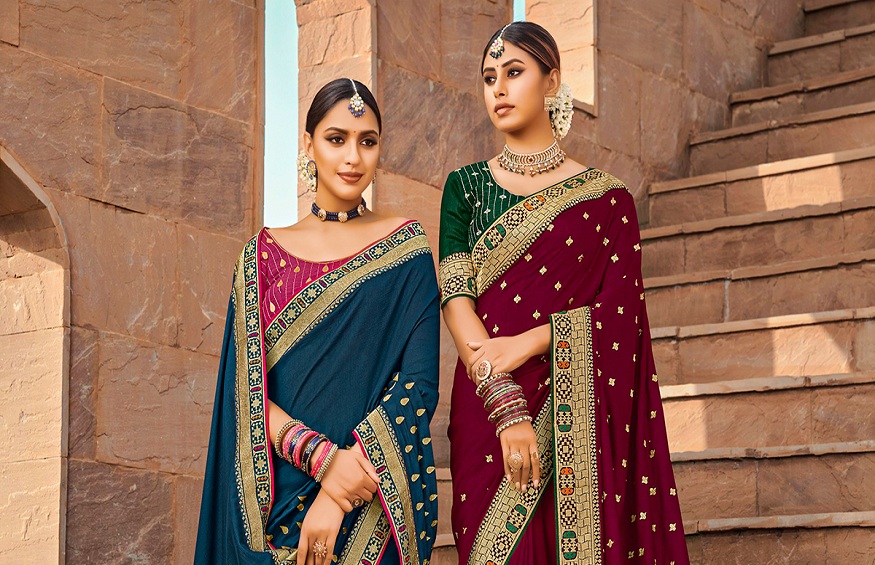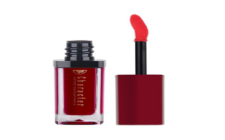Among the most stunning and amazing pieces of apparel is indeed the Indian saree. It’s a flawless synthesis of beauty and grace. It adheres to current fashion trends just as tightly as it is entrenched in its cultural past. It constantly glides in tangible fashion since it is so enormous and graceful. In actuality, the saree embodies both India’s regal civilisation and its rich cultural heritage. Whether you choose a traditional saree or a soft and beautiful organza work saree, it definitely will grab you loads of compliments.
Saree: Throughout the Prominent Periods
Sarees were first known to exist throughout the Maury as well as Sunga eras circa 300 BC. Some earliest depictions of sarees in art show a rectangular fabric piece wrapped around the subject’s body. Additionally, the saree is mentioned in the Ramayana and Mahabharata, two mythological epics.
People wore Neevi, traditional piece of cloth wrapped around the waist, during Indus Valley period, that also saw the rise of the Aryan kingdom.
The women representing royal and princely households also made sarees their distinctive attire. The terminology blouse and petticoat, together with the saree, were first employed during the initial periods of the British conquest. During the British era, it was fashionable to wear sarees in half but also decorate with tall boots!
The saree developed and soon crept into the comfort wardrobes of the working class throughout the years immediately before the era of independence. Throughout this time, the unique Nivi style of draping, which originated with the royal family and has since become an iconic design, also gained popularity. The trend of pinning your saree around one side originally emerged during this time, probably as a result of something like the broaches the British used.
India’s theatre and film came into their own in the years immediately following independence. Additionally, during this time down blouses became popular, which contrasted sharply with the traditionally fashioned blouses seen throughout the British era. This was also the commencement of saree fashion statements.
Bollywood as well as saree
In the years leading up to independence, as Indian film flourished and made a name for itself, silk saree also rose to popularity. The saree trend spread swiftly in Indian homes because of the stunning starlets who defined their own draping ways on television. The sarees became even more fashionable, and the fashion-forward women were eager to adopt the trends into their daily life.
Bollywood redesigned sarees with much more flamboyance as well as boldness as when the years went by. Sarees with a tinge of sheerness entered the scene and quickly evolved into the very next on-screen representation of sensuality. Sarees are no longer just associated with tradition; they started quickly evolving into the newest style of clothing.
In the modern day, sarees have become a universal symbol. Without the introduction of a new saree fashion, no Bollywood film is full. Sarees are elegant, fashionable, urbane, and incredibly chic. They radiate confidence while providing a glimpse into our history.
Interesting Statistics about Saree
A saree represents the only unstitched article of clothing that has matured more beautifully than the best wines, in addition to being the oldest.
There are more than a hundred different methods to drape sarees, and if majority individuals were to be believed, it is said a new draping style is being developed right now!
Although there are varying lengths designed to accommodate diverse fashions, the standard saree length remains 9 yards. One more style calls for 3.5 yards of such an outfit.
Anyone can wear this item of clothing, regardless of their height, age, as well as body shape, and the funny thing is that this garment comes in a single measurement size that corresponds to all styles.
The saree would be a recognised garment throughout every Indian region which is frequently worn as a novelty overseas. It is not limited about one cultural appropriation.
Different saree draping techniques that involve beautifully donning a saree without any blouse arise from India’s tribes and interior regions.
Indians are employed in large numbers by the country’s saree industry, which mostly comprises the handloom and embroidered industries.
The saree has distinguished itself in renowned fashion shows as well as a cutting-edge ramp costume, transcending its use as everyday clothing or festival attire. Modern designers are continuously working to create fresh design iterations again for wonder known as the saree. Every alphabet of said English alphabet has a saree variety name that begins with it.
Sarees may be the only item of clothing that has great sentimental value and is passed down through the generations.
The Classic Saree
The saree has a very exquisite quality that causes it to inadvertently exude an air of panache. These sarees are chic and fashionable; they are synonymous with elegance, and indeed the greatest part is that comfort is a given when wearing them. All of these qualities are embodied in one garment: it is sensual, glamorous, artistic, classic, and modernistic.
No matter the fabric—silk, cotton, georgette, or even any other saree enhances the woman’s radiant beauty. The saree effortlessly puts together the most elegant appearance for you.
Sarees are the height of elegance and give off a statuesque aura. Every saree exudes refinement and boasts delicacy, whether it is delicately stitched, intricately decorated, or one of the regional treasures like Kanjeevaram, Patola, the Paithani, Chanderi, or even Banarasi. One cannot go wrong with such a saree for any occasion, and its harmonious hues will enhance your appearance to the fullest.
Bonus Style advice
The most important thing to remember when adorning a saree would be to pay close attention towards the saree’s style. Fashionable sarees can go either way, i.e., being contrasted with traditional jewellery to keep the traditional character or coupled with modish items to look chic. Also, Traditional handcrafted sarees require substantial jewellery to set these off. However, a number of bangles may be worn with handcrafted sarees to complement a typical item of jewellery.
Traditional handloom sarees— Many cotton-based traditional sarees can indeed be worn with a thick beaded necklace that has a focal point striking piece. The handloom kind of silk sarees, in contrast hand, should be complemented with heavy metals plus jewellery to match the silk fabric. Another great tip would be to pair a traditional saree with a designer blouse online or brought physically.
Designer handloom sarees must be worn with carefully designed modern accessories to enhance the overall appearance by adding texture and patterns. Anybody can select to wear jewellery pieces in current shape well with designer variety.
Although the event for which the handmade sarees get worn greatly influences the cosmetics used, a striking bindi can always be added to finish the look.




